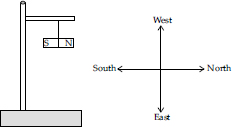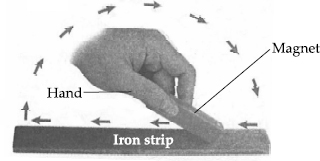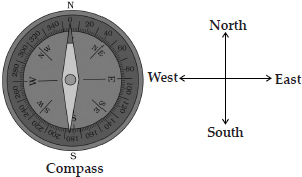Fun with Magnets - NCERT - NCERT Questions
Fill in the blanks in the following.
(i) Artificial magnets are made in different shapes such as ______, ______ and ______.
(ii) The materials which are attracted towards a magnet are called ______.
(iii) Paper is not a ______ material.
(iv) In olden days, sailors used to find direction by suspending a piece of ______.
(v) A magnet always has ______ poles.
(i) Artificial magnets are made in different shapes such as bar magnet, horse-shoe magnet and cylindrical magnet.
(ii) The materials which are attracted towards a magnet are called magnetic materials.
(iii) Paper is not a magnetic material.
(iv) In olden days, sailors used to find direction by suspending a piece of bar magnet.
(v) A magnet always has two poles.
State whether the following statements are true or false.
(i) A cylindrical magnet has only one pole.
(ii) Artificial magnets were discovered in Greece.
(iii) Similar poles of a magnet repel each other.
(iv) Maximum iron filings stick in the middle of a bar magnet when it is brought near them.
(v) Bar magnets always point towards North-South direction.
(vi) A compass can be used to find East-West direction at any place.
(vii) Rubber is a magnetic material.
(i) False. A magnet always has two poles independent of its shape.
(ii) False. Natural magnets were discovered in Greece.
(iii) True. Like poles repel each other while unlike poles attract each other.
(iv) False. Maximum iron filings stick at the ends of a bar magnet when it is brought near them.
(v) True. Bar magnets point towards North – South direction, when they are freely suspended.
(vi) True. A magnetic compass points towards North-South direction, if it is known, then the East-west direction can also be determined.
(vii) False. Rubber is not attracted to a magnet. So, it is not a magnetic material.
It was observed that a pencil sharpener gets attracted by both the poles of a magnet although its body is made of plastic. Name a material that might have been used to make some part of it.
SOLUTION:The blade of the pencil sharpener is made of iron. Iron gets attracted by the poles of a magnet as it is a magnetic material.
Q 4. Column I shows different positions in which one pole of a magnet is placed near that of the other. Column II indicates the resulting action between them for each situation. Fill in the blanks.
| Column I | Column II |
| N - N | ______ |
| N - ______ | Attraction |
| S - N | ______ |
| ______ -S | Repulsion |
| Column I | Column II |
| N - N | Repulsion |
| N - S | Attraction |
| S - N | Attraction |
| S - S | Repulsion |
Write any two properties of a magnet.
SOLUTION:Two properties of a magnet are as follows:
(i) Magnets attract objects made of magnetic materials like iron.
(ii) Like magnetic poles repel each other while unlike magnetic poles attract each other.
Where are poles of a bar magnet located?
SOLUTION:Poles of a bar magnet are located at both the ends of bar magnet.
North pole (N) and the South pole (S) of a bar magnet are shown in the figure.

A bar magnet has no markings to indicate its poles. How would you find out near which end is its north pole located?
SOLUTION:A freely suspended bar magnet always comes to rest in the North-South direction.
The geographical North facing end of the magnet is its north pole and the geographical south facing end is its South pole.

Hence, the unknown poles of a bar magnet can be marked by suspending it freely by a string.
You are given an iron strip. How will you make it into a magnet?
SOLUTION:Touch and stroke' method can be used to make an iron strip into a magnet. For this, a bar magnet is required. The bar magnet is moved along the length of the iron strip starting from one end to the other end.

Then, the bar magnet is lifted from the other end and brought to the starting point again with the same pole of the magnet. On repeating the process for about 30 - 40 times, the iron strip will become a bar magnet with two poles.
How is a compass used to find directions?
SOLUTION:A compass always points towards the North-South direction. The arrow of the compass needle indicates its North pole. The arrow always points in the North direction.

Once we know North direction, we can easily find out the other directions. e.g., if North is upwards, South will be downwards, East will be on right hand side and West will be on left hand side.
A magnet was brought from different directions towards a toy boat that has been floating in water in a tub. Affect observed in each case is stated in column I. Possible reasons for the observed affects are mentioned in column II. Match the statements given in column I with those in column II.
| Column I | Column II |
| Boat gets attracted towards the magnet. | Boat is fitted with a magnet with North pole towards its head. |
| Boat is not affected by the magnet. | Boat is fitted with a magnet with South pole towards its head. |
| Boat moves towards the magnet if North pole of the magnet is brought near its head. | Boat has a small magnet fixed along its length. |
| Boat moves away from the magnet when North pole is brought near its head. | Boat is made of magnetic material. |
| Boat floats without changing its direction. | Boat is made of non-magnetic material. |
| Column I | Column II |
| Boat gets attracted towards the magnet. | Boat is made of magnetic material. |
| Boat is not affected by the magnet. | Boat is made of non-magnetic material. |
| Boat moves towards the magnet if North pole of the magnet is brought near its head. | Boat is fitted with a magnet with South pole towards its head. |
| Boat moves away from the magnet when North pole is brought near its head. | Boat is fitted with a magnet with North pole towards its head. |
| Boat floats without changing its direction. | Boat has a small magnet fixed along its length. |